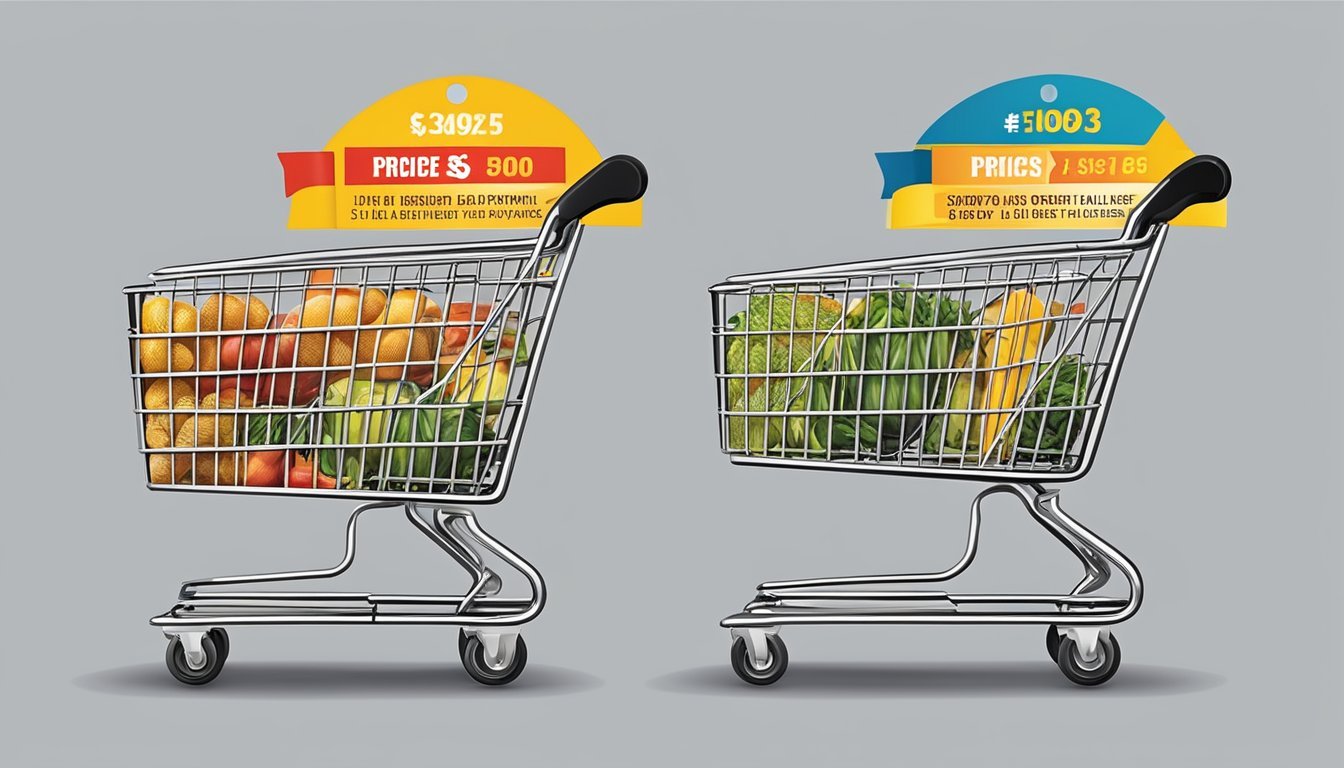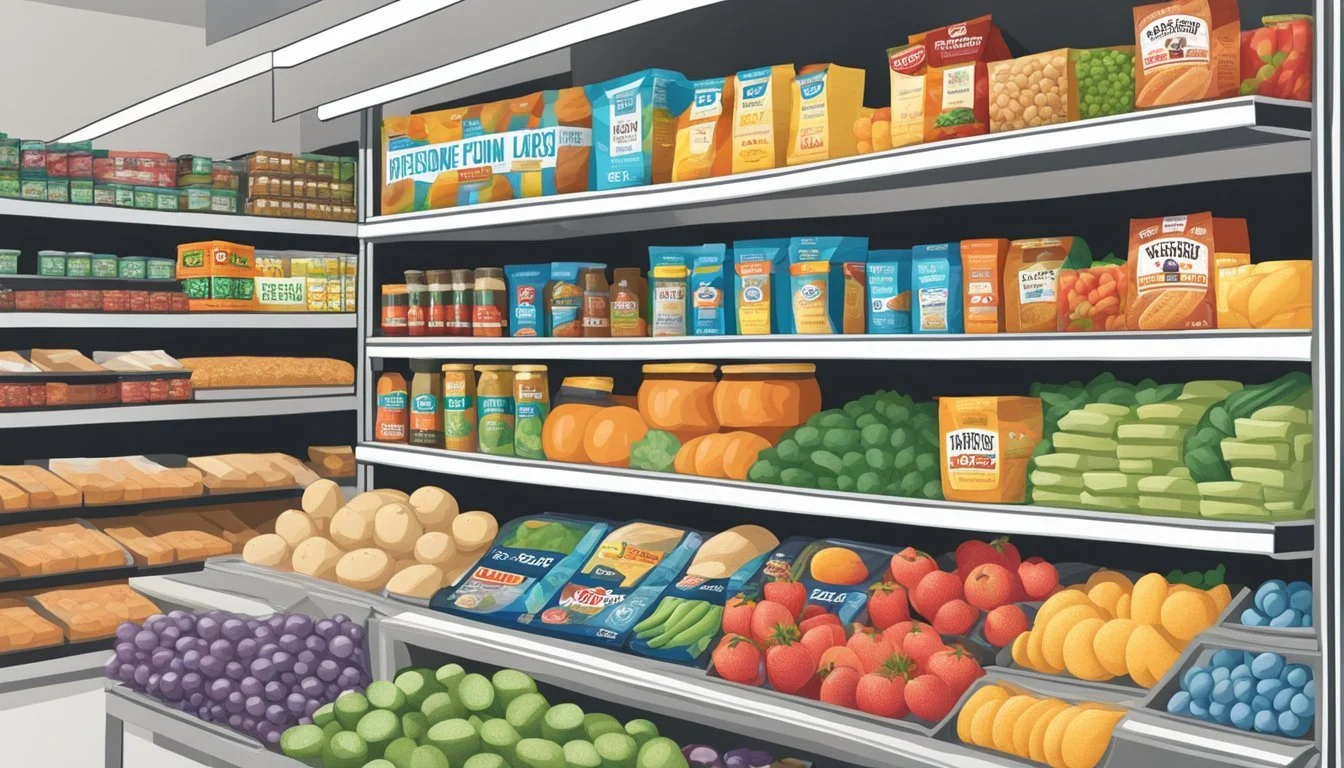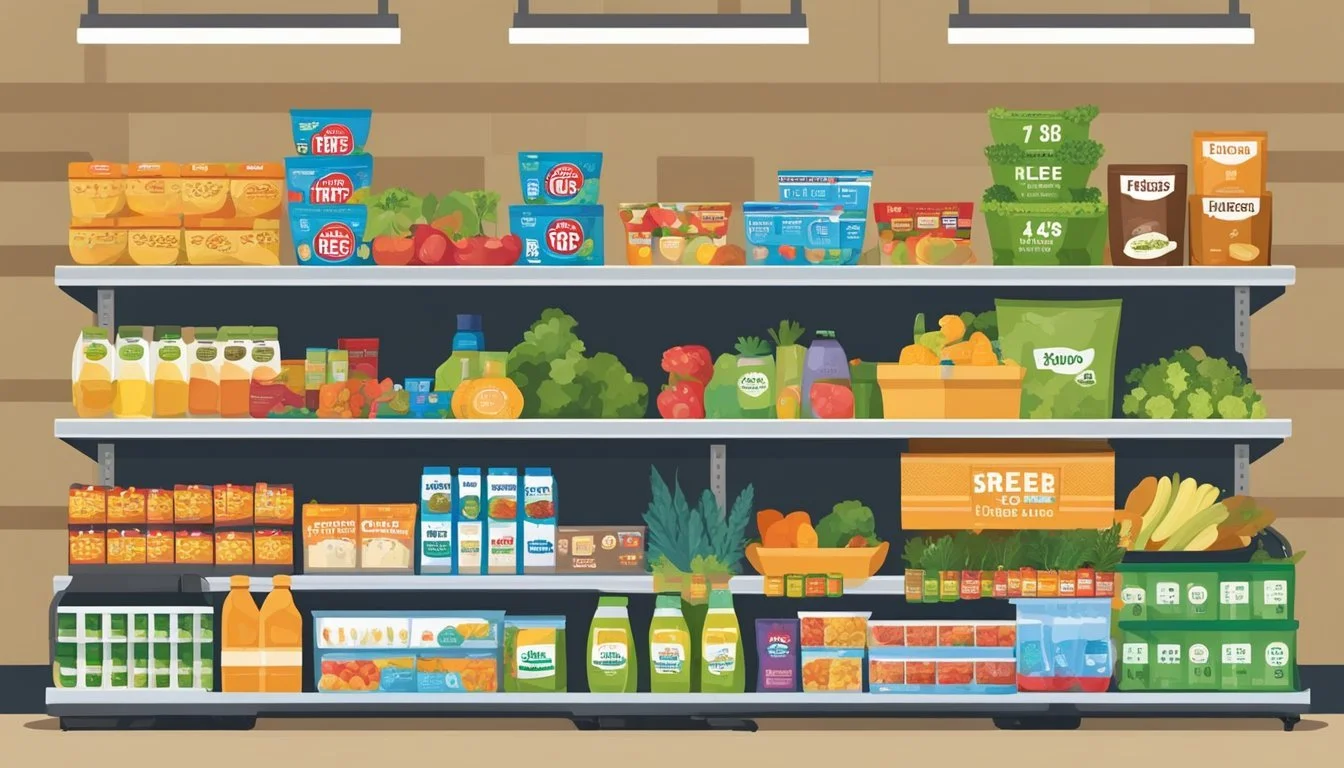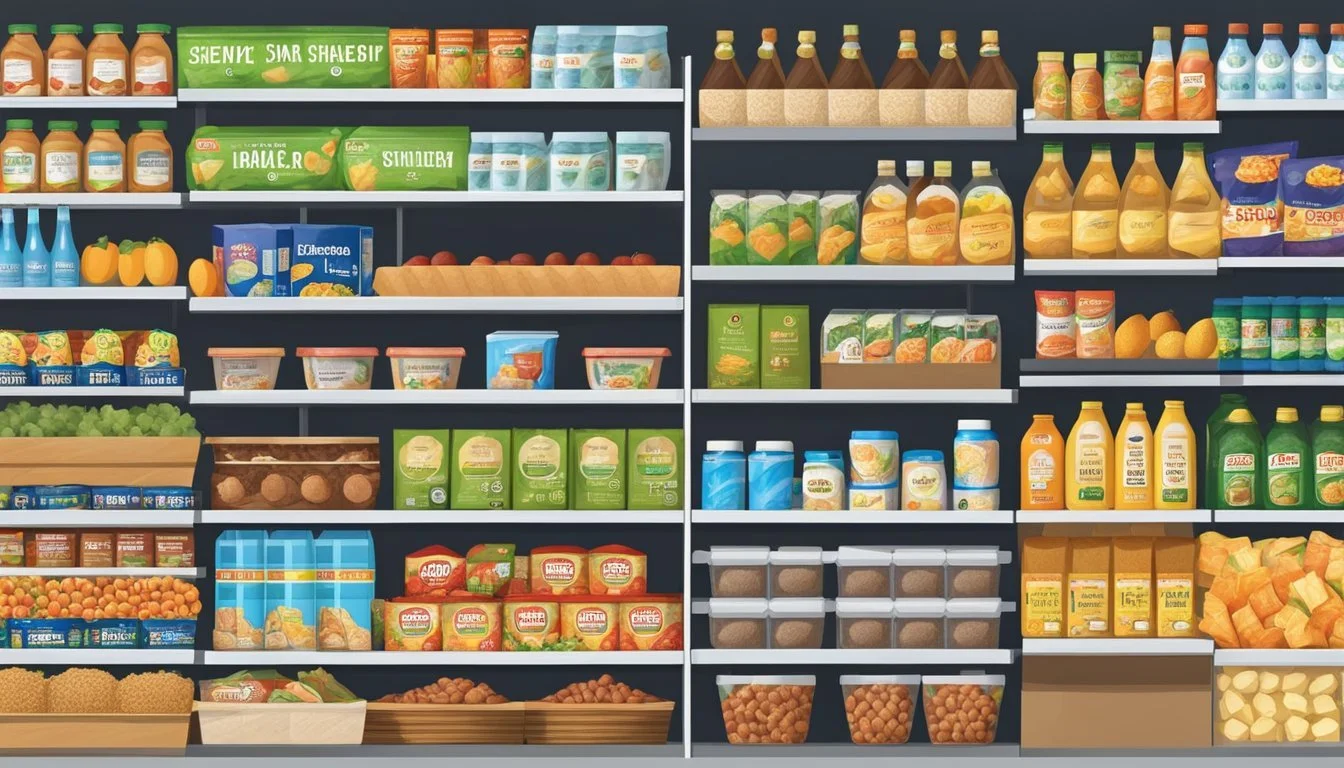Is H-E-B Cheaper Than Food Lion?
Comparing Grocery Store Prices
Part of Our Grocery Store Guide with Details on H-E-B Prices and Food Lion Prices
With the ever-rising cost of living, savvy grocery shoppers are on a constant quest to find the most affordable supermarket without compromising on quality. H-E-B and Food Lion are two regional grocery store chains with significant footprints in their respective areas. H-E-B, rooted deeply in Texas, is known for its wide array of products, including its Texas Heritage line of cured meats (What wine goes well with cured meats?), which has garnered popularity among its customers. Its commitment to providing local and unique offerings is a key aspect of H-E-B's appeal.
Food Lion, on the other hand, operates across the Southeast and Mid-Atlantic regions, offering an assortment of goods that cater to a budget-conscious demographic. Historically, Food Lion has been recognized for its competitive pricing strategy, which aims to offer value to its customers. Pricing at grocery stores can often be influenced by several factors, including location, product selection, store brand offerings, and promotions.
When comparing grocery shopping experiences between H-E-B and Food Lion, it's worth considering various metrics such as product freshness, variety, pricing of store brands, and availability of specialized items. Both stores have their own loyal customer bases and reputations for quality and value, but the question of which is cheaper may not have a one-size-fits-all answer. It can depend on individual shopping habits, regional pricing differences, and the specific products being compared.
Comparative Analysis of Grocery Pricing
This section meticulously examines the pricing dynamics between H-E-B and Food Lion, covering overall cost comparisons, item-specific pricing, and the impact of retailer promotions on consumer spendings.
Overall Price Comparison
When comparing the prices of H-E-B, a Texas-based grocer, to Food Lion, it is evident that regional factors significantly influence pricing strategies. While H-E-B is not ubiquitously available like Food Lion, which can be found in various states, H-E-B often offers competitive pricing that can rival or sometimes undercut Food Lion's prices. For instance, studies comparing H-E-B to national chains such as Walmart have shown that H-E-B can emerge as the more economical choice for many shoppers.
Walmart
Target
Publix
Costco
Sam’s Club
WinCo
Lidl
Trader Joe's
Food 4 Less
Walmart Supercenter
Price of Specific Items
A detailed look at specific grocery items reveals the nuances in pricing between the two stores. For example, H-E-B's focus on local supplier partnerships often allows it to price produce more competitively compared to Food Lion. Additionally, bulk items like a dozen eggs and generic brand staples may be less expensive at H-E-B, reflecting its strategies to keep prices low.
Eggs: H-E-B - $2.52, Food Lion - Varies by location
Milk (generic brand, per gallon): H-E-B - Cheaper at select stores, Food Lion - Subject to regional pricing variations
Bread (store brand): H-E-B - Typically lower cost, Food Lion - Competitive with regional discounts
Influence of Retailers' Promotions
Promotions and discounts are key elements that alter the final cost to the consumer, and both H-E-B and Food Lion run frequent promotional campaigns. However, H-E-B's aggressive discounting and coupon strategies might offer more savings opportunities, which can affect the overall cost for consumers who are savvy with deals and timing their purchases around sales events.
Weekly circulars: H-E-B often provides substantial weekly deals.
Online coupons: Both retailers offer online coupons, but H-E-B's digital coupon system is robust, with tailored savings.
Bulk discounts: H-E-B and Food Lion provide discounts for bulk purchases, with H-E-B occasionally having the edge in price per unit during sales.
Quality and Variety of Products
When comparing H-E-B and Food Lion, a distinct difference exists in the range and caliber of products provided by each grocery chain. Customers can expect variations in produce, organic options, meats, dairy, and pantry staples.
Produce and Organic Offerings
H-E-B prides itself on a robust selection of fruits and vegetables, with full-service supermarkets generally offering a wider variety compared to discount stores. Organic shoppers are well-catered for, with H-E-B providing an extensive array of organic produce. Food Lion also offers organic produce, but the range may vary by location.
H-E-B: Wide variety of fruits and vegetables, including organic options.
Food Lion: Sufficient variety with organic selections available.
Meats and Dairy Selection
In terms of meat and dairy, both H-E-B and Food Lion offer a comprehensive selection that covers the usual array of beef, poultry, pork, and seafood. Dairy sections are well-stocked, including options for milk, cheese, eggs, and yogurt. H-E-B is known for high-quality products, which also extends to its meat and dairy offerings.
Meat: Both stores provide fresh, frozen, and specialty meats.
Dairy: A variety of milk, eggs, cheese, and other dairy products can be found.
Availability of Dry Goods and Canned Items
Shoppers hunting for pantry essentials like spices, bread, dry goods, and canned items will find H-E-B and Food Lion competent in supplying these needs. H-E-B's selection of dry goods often includes a mix of mainstream and specialty products. They also carry a range of affordable and premium spices. Food Lion has a reliable stock of dry goods and canned items, but the variety in spices and premium brands may be more limited than at H-E-B.
Dry Goods: Both stores have a solid inventory of rice, pasta, and grains.
Canned Goods: Ample supply of vegetables, fruits, and other canned products.
Spices & Bread: H-E-B likely to have a broader range of spices and freshly baked bread.
Store Brands and Exclusive Products
In the competitive grocery landscape, store brands and exclusive product lines are crucial differentiators for retailers like H-E-B. They offer customers value-focused options compared to national brands.
Private-Label Options
H-E-B provides a wide array of private-label products that encompass staples such as rice, beans, and peanut butter. Customers shopping at H-E-B can often find these items at lower price points than national brand counterparts. For example, their private-label rice and beans are offered in multiple varieties, catering to diverse culinary needs while ensuring affordability.
H-E-B Rice: Includes varieties like basmati, jasmine, and brown rice.
H-E-B Beans: Available in canned and dry forms, including pinto, black, and kidney beans.
Furthermore, H-E-B's H-E-B Plus locations enhance the shopping experience by featuring an extended selection of these private-label items.
Exclusive Food Lines
H-E-B's exclusive food lines extend to fresh produce and ready-made items like hummus, tortillas, and apples. Their in-store tortillerias are known for freshly made tortillas, a product that has garnered a loyal customer following.
H-E-B Hummus: A range of flavors that cater to various taste preferences.
H-E-B Apples: Quality selections often promoted alongside other fresh produce.
By controlling production and distribution, H-E-B ensures its exclusive lines maintain consistent quality, giving them an edge over competitors like Food Lion. These exclusive products not only provide quality but also enhance H-E-B’s brand identity in the grocery market.
Shopping Experience
When comparing the shopping experience at H-E-B and Food Lion, customers should consider the convenience of store locations and the comfort found within the store's layout.
Store Location and Convenience
H-E-B's store locations tend to be densely populated in Texas, providing significant convenience for residents within the state. Specifically focusing on store location, H-E-B has crafted a strong local presence, often placing stores strategically in neighborhoods to serve a localized clientele. For delivery services, H-E-B offers H-E-B Home Delivery and Curbside Pickup, enhancing the convenience for the shopper.
Food Lion, meanwhile, operates primarily in the Southeastern and Mid-Atlantic regions. While their footprint isn't as state-centered as H-E-B's, they offer a widespread availability that caters to a broader regional grocery shop audience. Food Lion also offers a delivery service, in partnership with Instacart, providing an alternative shopping option for eaters seeking convenience.
Layout and Shopping Comfort
Shoppers often praise H-E-B for a layout that's conducive to a quick and comfortable shopping experience. The stores are laid out in a way that makes it easy for shoppers to find what they need without unnecessary confusion. Moreover, wide aisles and well-organized sections contribute to a pleasant grocery shop experience.
Food Lion stores typically offer a clean, straightforward layout designed with the shopper's convenience in mind. The emphasis is on facilitating a smooth flow through the store. While the stores may not boast the same regional specificity in products as H-E-B, they maintain an orderly environment that makes shopping efficient for the general customer base.
Cost-Saving Strategies for Shoppers
Effective cost-saving strategies enable shoppers to maximize their savings at stores like H-E-B and Food Lion. These strategies involve using coupons and discounts, taking advantage of membership benefits, and employing budget-friendly shopping techniques for everyday purchases.
Utilizing Coupons and Discounts
Coupons play a significant role in reducing grocery bills. Shoppers should regularly check both H-E-B and Food Lion's weekly ads, digital coupon offerings, and in-store displays for any available discounts. Most of the time, combining store coupons with manufacturer coupons provides the best value on purchases.
Digital Coupons: Sign up for each store's digital platform to access and load coupons directly to the loyalty card or account.
In-Store Discounts: Keep an eye out for clearance items and in-store promotions that can be combined with coupons for increased savings.
Membership Benefits and Rewards
Membership programs are instrumental in saving money at grocery stores. Both H-E-B and Food Lion offer rewards programs which accrue points based on purchases that can later be redeemed for discounts.
H-E-B Points Program: Offers points per dollar spent, which can be redeemed for discounts on future purchases.
Food Lion MVP Rewards: Provides personalized offers and savings based on shopping history.
In addition, shoppers should:
Sign up for newsletters and emails to receive exclusive members-only promotions.
Take note of any special days or periods where bonus points are awarded to maximize earnings.
Budget-Friendly Shopping Tips
Shoppers who are mindful of their spending and strategic in their approach can greatly reduce their grocery expenditure.
Budgeting: Establish a clear budget before shopping and stick to it, leveraging the power of meal planning to buy only what is necessary.
Buying in Bulk: Purchase non-perishable items and staples in bulk during sales to save money over time.
Meal Plan: Plan meals around the sales and seasonal items to ensure every grocery trip delivers the best bang for the buck.
Best Value: Compare unit prices on the shelf to find which package size offers the best value for money.
Following these strategies not only helps shoppers save money but also encourages practice in mindful spending, ultimately leading to a more refined approach to grocery shopping.
Consumer Education on Grocery Shopping
When navigating the grocery landscape, consumers must understand category distinctions, unit pricing, and the impact of seasonal shopping on their budget. Educating oneself in these areas helps make informed decisions, potentially leading to a healthier and more cost-effective grocery bill for a family of 4 or any household size.
Understanding Grocery Categories
Groceries can be divided into several categories such as produce, dairy, meats, dry goods, and frozen items. Each category serves different nutritional needs, with produce and dairy often providing essential vitamins and minerals. For instance, a carton of 2% milk is a common dairy choice for families seeking a balance between fat content and nutritional value.
Decoding Unit Prices and Bulk Purchases
Unit prices offer a comparison of costs across various sizes and brands, enabling shoppers to identify the best deals. A product may seem cheaper when bought in small quantities, but often, purchasing in bulk can lead to significant savings. Consumers should compare the unit price (price per ounce, liter, etc.) to ensure they are getting the most value for their money.
Emphasizing Seasonal and Sale Items
Purchasing seasonal items when they are on sale is an effective strategy for keeping a grocery bill within budget while also enjoying fresh, flavorsome produce. Shoppers should also be aware of sale cycles and discount promotions, which can make even specialty items more affordable. Adhering to a shopping list that incorporates these cost-saving measures helps maintain a healthy and cheap grocery budget.
Store Policies and Operations
When evaluating H-E-B’s services relative to Food Lion, it is essential to consider their return policies and customer satisfaction initiatives, as well as the stock availability and the freshness of their items. H-E-B prides itself on fresh produce and extensive stock, while Food Lion focuses on competitive pricing and customer care.
Return Policy and Customer Service
H-E-B offers a straightforward return policy where customers can return items with or without a receipt; the method of reimbursement can vary. They have consistently been recognized for high customer service levels, and also provide rental services for equipment, enhancing their service offerings.
With receipt: Reimbursements are issued in the original form of payment or store credit.
Without receipt: The customer typically receives store credit.
Food Lion also has a generous return policy, aiming to guarantee customer satisfaction. The store facilitates product returns with a receipt, and if the customer is dissatisfied, they offer a double-money-back guarantee on store brands.
With receipt: A hassle-free return with a refund or exchange.
Double-money-back guarantee on store brands for customer satisfaction.
Stock Availability and Item Freshness
H-E-B keeps a robust inventory with an emphasis on freshness, often sourcing products from local suppliers. The grocery chain makes considerable efforts to maintain stock, including in their private brands, to ensure customers have access to a wide variety of goods.
Product Freshness: Emphasizes locally sourced produce and meats.
Inventory Management: Utilizes advanced stocking methods to minimize out-of-stocks.
Food Lion strives to provide a comprehensive shopping experience as well, with a decent variety of items available. The company is known for employing effective inventory systems to avoid advertising goods they cannot supply.
Product Freshness: Offers a range of fresh items, though it may not match the local emphasis of H-E-B.
Inventory Tracking: Employs an efficient system to maintain stock levels corresponding with customer demand.
Both retailers operate with the understanding that availability and freshness are pivotal to customer satisfaction and incorporate these principles differently into their store operations.
Broader Context in Grocery Retail
In assessing grocery pricing, it's essential to consider both the macroeconomic landscape and the evolving habits of consumers.
Economic Factors Affecting Grocery Prices
Factors such as inflation, supply chain disruption, and agricultural output influence grocery store pricing. Specifically, Safeway and WinCo Foods, similar to other grocery retailers, must navigate these challenges to maintain competitive prices. National economic trends significantly impact their ability to offer lower prices than competitors like H-E-B or Food Lion. For example, when fuel prices rise, transportation costs for grocery chains increase, often leading to higher prices for consumers.
Market Trends and Consumer Behavior
Consumer preferences and shopping patterns are shifting, with a notable migration towards omnichannel experiences blending in-store and online shopping. During the pandemic, Market Basket observed increased digital sales, but traditional chains like Trader Joe’s have maintained strong customer loyalty due to their unique in-store experience. As American consumers become more price-sensitive amidst fluctuating food prices, grocery chains strategize to balance customer expectations with profitability to stay ahead in a competitive market.
Comparisons with Other Grocery Chains
When analyzing the affordability of grocery chains, H-E-B and Food Lion are often compared to national brands across various regions to determine where consumers can find the cheapest groceries.
H-E-B and Food Lion vs. National Brands
H-E-B, based in Texas, is recognized for its competitive prices and localized product offerings. While not as widely spread as some of the national brands such as Walmart and Costco, it maintains a strong presence in the retail market, especially in Texas. For instance, a dozen eggs at H-E-B is priced at $2.52, only slightly higher than Costco's $2.35 and lower than Walmart's $2.58. This indicates that H-E-B manages to offer close competition to these national retailers in terms of price while also providing a variety of products tailored to local preferences.
Food Lion, on the other hand, as a supermarket chain operating in the Southeast and Mid-Atlantic, competes with these national brands by offering a wide selection of goods and frequently promoting discounts. Although specific price comparisons between Food Lion and national brands like Walmart or Costco are not provided here, consumers generally perceive Food Lion as providing reasonable prices and a good variety of everyday groceries.
Regional Variations in Grocery Pricing
The cost of groceries can vary notably depending on the region. Supermarkets like H-E-B and Food Lion may adjust their pricing strategies based on the cost of living, transportation, and competitive pressures in each locality. For example, in Texas, retailers must be keenly aware of regional pricing trends to maintain affordability as they are competing not only with each other but also with national chains operating in the area.
Supermarkets in different regions offer specials and discounts that reflect the local market demands, which can make them more affordable in some areas compared to others. Local sales tax variations also impact the final price paid by consumers. These regional pricing strategies are essential for supermarkets to attract cost-conscious shoppers who are looking for the best value for their money.
through this factual presentation, readers can understand the competition between H-E-B, Food Lion, and national brands within different regions and their impact on grocery pricing.
Additional Considerations
When comparing H-E-B and Food Lion, shoppers should consider not only the pricing of items but also product variety and availability, particularly for those with specific dietary needs, and the range of non-grocery items and services offered.
Dietary Specificities and Food Preferences
Shoppers with particular dietary preferences or requirements, such as gluten-free, organic, or vegan options, might find a difference in selection and pricing between H-E-B and Food Lion. H-E-B may offer a wider range of local Texan products, including a selection of Texas Heritage cured meats and a variety of fresh produce, while Food Lion might have a different assortment, with emphasis on shelf stability and regional preferences. Consumers interested in specialty items like olive oil, soy products, or dairy alternatives should compare the stores' offerings, as these can notably vary in price and availability.
Cereal and Pasta: The cost of everyday staples like cereal and pasta may differ, impacting the overall grocery bill.
Coffee and Wine: Both chains carry a variety of coffee and wine, with regionally influenced selections potentially affecting affordability.
Deli and Frozen Foods: The deli section and frozen food aisles often offer brand-specific products, which might sway cost-effectiveness in favor of one retailer over the other.
Non-Grocery Items and Additional Services
Beyond food items, both H-E-B and Food Lion provide customers with non-grocery goods and services that can influence shopping decisions.
Toys and Drugs: While H-E-B may offer competitive prices on basics and grocery, its variety of non-grocery items such as toys and pharmacy products could sway the cost-benefit analysis.
Additional Services: Each store may have different additional services such as pharmacies, photo centers, or banking services that add value to the shopping experience beyond just food prices.
In summary, when comparing H-E-B and Food Lion, it’s important to consider how the selection and pricing of dietary-specific foods and non-grocery merchandise can affect the overall shopping experience and budget.








